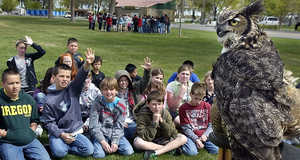forum
library
tutorial
contact

Salmon Summit Turns Columbia Park into Classroom
by Jacques Von LunenTri-City Herald, May 4, 2011
|
the film forum library tutorial contact |

|
Salmon Summit Turns Columbia Park into Classroom
by Jacques Von LunenTri-City Herald, May 4, 2011 |
 KENNEWICK -- The group of young boys gathered in Columbia Park were waiting for their cue to jump.
KENNEWICK -- The group of young boys gathered in Columbia Park were waiting for their cue to jump.
Finally, the young woman in the middle of the circle said the magic words: "Clean Water."
The boys leapt forward with a yell.
"Stonefly," they hollered, proving they had paid attention in the most entertaining biology lesson of the year.
The annual Salmon Summit draws almost 4,000 elementary school students to Kennewick's shore of the Columbia River. The event, which is organized by the Benton and Franklin conservation districts, turns a large section of the park into an outdoor classroom for two days.
The leaping boys were among a large group of fifth-graders from Badger Mountain Elementary in Richland. The group had gathered around Jacqueline Upshur, an outreach specialist from the Water and Environmental Center at Walla Walla Community College.
The kids learned from Upshur that the health of a stream can be judged by the invertebrates that survive in it.
She split the kids into four groups, each representing a different little critter, and had them stand in a circle.
"OK, I'm a really dirty river," Upshur called out.
The leeches rushed to the center of the circle, i.e. the water they could survive in. The stoneflies had to wait until late in the game.
"The stonefly does not like pollution," student Nate Burton said afterward.
"It likes clean, cold, riffled water," Nick Conrad chimed in.
Neither boy had ever heard of the stonefly -- let alone its personal preferences -- before this day at the river.
And that station was only one of many spread around a large area of the park Tuesday.
There were spots featuring live raptors, a truck from the Army Corps of Engineers used to ferry fish around dams, a chance to dress up as plants and the animals that feed on them, and much more.
Earlier in the day, the students had released little fish into the river, capping off the Salmon in the Classroom program, which had kids raise salmon fingerlings since January.
In a first this year -- the summit started 11 years ago -- biologists from the National Oceanic and Atmospheric Administration demonstrated how fish are tagged.
The two men took two-inch long spring Chinook, put them into water containing an anesthetic and then injected a small computer chip into the fish. It's part of the agency's work to help dam operators protect fish, said biologist Steve Achord.
Most dams have built-in scanners that read the chips inside the fish, helping reveal the salmon's migration behavior.
The kids crowded around the table holding scales, computers and anesthetized fish.
The students will be able to track the movements of fish released by Achord on Tuesday. Each chip is fed data, including the fish's weight and length at release, and gets a unique number. The teachers can email Achord, who'll be able to tell them which dams the fish have passed.
Kids and salmon can stay in touch, so to speak. Organizers hope the kids stay in touch with science, too.
"We have experts in the field come together with students, who will be the experts of the future," said Rachel Little, a fish biologist with the Benton Conservation District, who coordinated the event.
learn more on topics covered in the film
see the video
read the script
learn the songs
discussion forum
